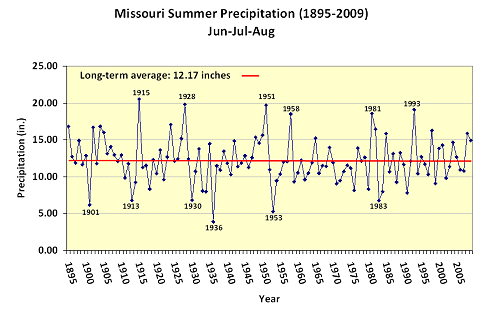
Less Variance in Summer Precipitation Patterns over Missouri, and Wetter too
Pat Guinan
State Climatologist
Commercial Agriculture/University of Missouri Extension
There are many benefits to having long term climate records including the ability to detect trends over time and to identify cycles or data variance. Missouri has an established database of temperature and precipitation records for several locations in the state that began with a handful of weather stations in 1895 and has expanded to nearly 200 today. Not only does the data provide information that documents variability in our climate, it can also be used to perform risk assessments for weather-sensitive activities such as agriculture.
With summer here, it's interesting to see what trends Missourians have experienced in recent and past summers. Figure 1 illustrates summer precipitation totals over the past 115 years in the Show-Me state. One notable feature is the large variance in summer rainfall that existed from the beginning of the period through the 1950's and how precipitation patterns have dampened after that. Extreme droughts were more commonplace in the earlier period of record as shown in the top three driest summers: 1901, 1936, and 1953. The top three wettest summers occurred in 1915, 1928 and 1951.
Additionally, Missouri summer precipitation patterns have trended wetter over the past 24 years compared to the period beginning in the early 1950's and continuing through the early 1980's. For example, during the 33 year period starting 1952 through 1984, there were only 8 summers in Missouri with above normal rainfall. Alternatively, since 1985 there have been 12 summers with above normal precipitation and 13 drier than normal.
 |
| Figure 1. |












